Description
Sandhyopasana
Sandhyopasana literally means ‘worship at the junctions of time.’ It is
a prayer and worship offered to the Lord at the junction (Sandhi) of
night and morning, forenoon and afternoon and at the junction of evening
and night. The Arghya pradana to the sun and the meditation on and
recitation of Gayatri, form the heart of the worship. Properly
understood, the whole Sandhya is an earnest prayer addressed to the Lord
to forgive all one’s sins committed during one’s routine, daily
activities and to bestow illumination and grace.
Sandhyopasana must be performed at the proper Sandhyas. Then only the
performer can derive much merit. There is a special manifestation of
force at Sandhyas. This force disappears when the Sandhya is past.
An Obligatory Duty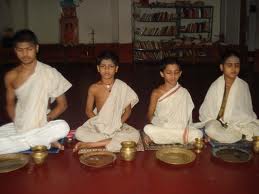
Sandhyopasana is the daily religious practice of the Hindus whose
investiture with the holy thread has been performed. Sandhya is a Nitya
Karma or an action that is to be done daily. Sandhya is an obligatory
duty to be performed daily for self-purification and self-improvement.
Sandhya should be performed by all followers of the Sanatana Dharma.
Every Brahmachari and every householder must perform it every day. If he
fails to perform it, there is Pratyavaya Dosha or the sin of omission.
He loses his Brahma-Tejas.
According to the Hindu Sastras, a Brahmana, a Kshatriya and a Vaisya
will get hell, if they do not perform three times Sandhyopasana (Traikalika
Sandhya) daily. It is for the purpose of Sandhya only, the law of
Yajnopavita-Samskara is laid down in the Yajnavalkya Smriti which says:
“The Brahmana in his eighth year, the Kshatriya in his eleventh year and
the Vaisya in his twelfth year are fit to be given Yajnopavita.”
Because, only after this particular Samskara, they are supposed to be
worthy to worship Sandhya and take to Vedic rites. They should keep
themselves pure internally and externally. They can nicely understand
the sacred glory of this divine science.
Benefits Of Sandhyopasana
Sandhya is a combination of Japa, Upasana, Svadhyaya, meditation,
concentration, Asana, Pranayama, etc. He who does Sandhya daily has
Brahma-Tejas or spiritual lustre, in his face. A man who performs his
daily Sandhya, according to the prescribed rules, at the appointed time
as laid down in the scriptures, attains purity and success in his every
effort. He becomes powerful as well as calm. Regular Sandhya cuts the
chain of old Samskaras and changes everybody’s old situation entirely.
It brings purity, Atma-Bhava, devotion and sincerity.
The Ceremony
The important features of this ceremony are: (i) Achamana or sipping of
water with recitation of Mantras (viz., Achyutaya Namah, Anantaya Namah,
Govindaya Namah, etc.), Marjana or sprinkling of water on the body which
purifies the mind and the body, Aghamarshana or expiation for the sins
of many births, and Surya Arghya or oblations of water to the Sun-god,
(ii) Pranayama or control of breath which steadies the wandering mind,
and silent recitation of Gayatri, (iii) Upasthana or religious
obeisance.
Arghya
The first part up to Arghya consists of hymns addressed to water and its
benefits. The sprinkling of water on the face and the head and the
touching of the different organs (the mouth, nose, eyes, ears, chest,
shoulders, head, etc.) with wetted fingers, are meant to purify those
parts of the body and invoke the respective presiding deities on them.
They also stimulate the nerve-centres and wake up the dormant powers of
the body.
The Arghya drives the demons who obstruct the path of the rising sun.
Esoterically, lust, anger and greed are the demons who obstruct the
intellect from rising up. The intellect is the sun.
Pranayama and Japa
The second part of Sandhya consists of Pranayama and Japa of Gayatri.
Suryopasthana
The third part of Sandhya is the Suryopasthana. It is a prayer for
forgiveness, mercy and grace. The prayer is: “Let me not go down to the
earthly house. Have mercy, O Lord! My strength was very weak, O Lord! I
did wrong actions. Have mercy, O Lord!” These are Vedic hymns addressed
to the sun in the morning, noon and evening. The sun is the intellect in
man. Ignorance is the night. Knowledge is the light. When you rise up
from the darkness of ignorance, when the eye of intuition is opened
through the grace of Gayatri, the Blessed Mother of the Vedas, you
attain eternal bliss, supreme peace and immortality. It is that divine
light which dispels delusion and the darkness of ignorance. It is that
adorable splendour with which the world is glowing. It is that holy
lustre which graciously fills the heart of a devotee with eternal bliss.
It is this supreme Light which the aspirant craves from God through the
Gayatri Mantra. He begs of God this Knowledge for his Realisation.
Sandhyopasana—An Exact Science
Man naturally wants to realise the Truth. He wants to know the secret of
Creation. In this connection, scriptures emphatically declare: “Only at
the moment when all doubts are cleared, ignorance is destroyed,
hypocrisy and cruelty are rent asunder, and when a man sees Him in the
abode of his heart, the real and ultimate Truth is revealed.”
Sandhya-Vijnana or the Science of Sandhya is an exact science to attain
success in the realm of Truth. One need not have any kind of
superstition to learn this divine science. One need not prove its
greatness. Its greatness, its glory, is open truth. Even the
materialistic society of today agrees with the truth of Sandhya-Vijnana.
In the scriptures, it is laid: “Brahmanhood is the tree, Sandhya is its
root, Vedas are its branches, religious acts are its leaves; therefore
take care of its root, i.e., Sandhya.” Now the glory of Sandhya is very
clear. Sandhya is absolutely necessary for a man who is treading the
path of Truth. Aharahah Sandhyamupasita, i.e., a Brahmin should perform
regularly his daily Sandhya at any cost—is the injunction of the
scriptures.
Prerequisites For The Practice Of Sandhya
Food Diet
If you want to learn this science, you must be careful about your diet.
Take regular and light Sattvic food. Man is much influenced by his diet.
See the difference between a small lion and a big elephant. You will be
able to improve yourself by adjusting your diet. Idleness is due to a
variety of rich diet only. Therefore, be strict in your daily diet. You
will be ever active and strong.
(Asana) Sitting Pose
A man who performs Sandhya does not care about his sitting pose. He sits
in any posture. This is not much beneficial. He should daily sit in a
perfect posture, Padmasana or Sukhasana, facing the particular
direction. As far as possible, he must finish his Sandhya in one
sitting. He must have perfect mastery over Asana. Then he will have
concentration in his Sandhya.
Shradha (Faith and Devotion)
You must do your Sandhya with faith and devotion. Mere repetition will
not bring much good. Pray from the core of your heart to the Lord to
forgive your sins.
A Word To The Younger Generation
Our young college students, who are under the influence of wrong
Samskaras and wrong education and evil company, have forgotten all about
the glory and high efficacy of Sandhya. They are not doing Sandhya.
Sandhya has no meaning for them. They have become Godless men. They want
laboratory tests and scientific proofs for the usefulness of Sandhya,
before they begin to do Sandhya. It must be supported by the statements
of western scientists. The words of ancient Rishis do not appeal to
them. What a greatly degraded state!
O young students! Do not ruin yourself by neglecting Sandhya. Regular
performance of Sandhya will give you success in life and material and
spiritual prosperity, good health and long life, purity of heart, and
help you to attain God-realisation. Do it from now at least. Yet there
is hope for you. Wake up. Be sincere.
Now take strict resolve from this very moment to be regular in your
daily Sandhya, even under many distractions and obstacles. Begin it from
this very moment. Do not delay. Reduce your useless activities. Talk
little. Do not mix much. You will get plenty of time for your Sandhya.
Be strict in your Sandhya. Let there be rain or wind. Even if the
Pralaya comes, do not leave it half-done. Many people say that they have
not got time to perform Sandhya. They have to attend several functions.
This is due to their weakness and lack of good Samskaras. They do not
know the glory of this divine science. If they see one of their friends
sitting on the banks of the river and performing Sandhya, they will
begin to shout or they will play some sort of mischief. But these poor
creatures do not know what secret is hidden behind the Sandhya. The
Secret of secrets is hidden in this sacred performance. This is why
ancient Rishis say: “One who does not perform daily Sandhya is a real
animal.”
May God give you the mind to perform daily Sandhya at any cost. May you
follow the rules of Sandhya. May you realise the glory of
Sandhya-Vijnana and be free from all tribulations and torments. May the
divine science named Sandhya-Vijnana bestow purity, immense joy and
immortality on you!
The Ten Scriptural Samskaras (More
details)
The rites that pertain to the stages of life of man are called Samskaras.
The Samskaras are purificatory rites which sanctify the life of the
Hindu. They give a spiritual touch to the important events in the life
of the individual from conception to cremation. They mark the important
stages of a man’s life. Just as the outline of a picture is lighted up
slowly with the filling in of many colours, so also is Brahmanya with
scriptural Samskaras. There are the Samskaras of childhood, of boyhood,
of manhood and of old age and death.
There are fifty two Samskaras. Among these, ten are important. The ten
principal and generally recognised Samskaras are: Garbhadana, Pumsavana,
Simantonnayana, Jatakarma, Namakarana, Annaprasana, Chudakarma,
Upanayana, Samavartana and Vivaha. Of these ten, only some are now
performed. Some of the Samskaras pertain to infantile life and early
childhood. Some are ceremonies which may be performed daily or on
special occasions. The whole life of the Hindu is thus consecrated and
protected from the cradle to the grave.
Garbhadana
The Garbhadana sanctifies the creative act. The husband prays fervently
from the core of his heart that a child may be conceived. He repeats
sacred Mantras during Ritu-Santi ceremony or nuptials. The new child is
conceived amidst the vibration of Mantras. Good impressions are
impressed in the brain-cells of the embryo. For a real Hindu who is
endowed with pure intellect and right understanding, the sexual union is
not for the sake of mere enjoyment. He utilises the divine, creative,
vital energy for the formation of a human body. Husband and wife should
be cheerful and pious when they have intercourse. When their minds are
perturbed or agitated, or when there is anger or hatred, they should
avoid copulation. They should study holy scriptures. If they have the
image of Arjuna, they will have a chivalrous and wise son. If they have
the image of Lord Buddha, they will bring forth a son with mercy and
other good virtues. If they have the image Of Dhanvantari, they will get
a son who will turn out to be a reputed Ayurvedic doctor. If they think
of Surya or Sun-God, they will bring forth a lustrous son with splendour
and effulgence.
Pumsavana
In the third month, the Pumsavana is performed with Mantras. The
food-sheath and the vital-sheath of the child are formed.
Simantonnayana
The Simantonnayana is performed at the seventh month with recitation of
Veda Mantras. This protects the mother from evil influences and bestows
health on the child. The above three Samskaras protect the mother and
the child. The body of the child develops nicely. The harmonious
vibrations set up by the recitation of Mantras and the performance of
the ceremonies help in shaping the body of the child beautifully.
Jatakarma
The next Samskara, the ceremony performed immediately after the birth of
the child, is the Jatakarma. The father welcomes his new-born child. He
prays for its long life, intelligence and well-being, and feeds it with
honey and butter.
Namakarana
Then comes Namakarana or the naming ceremony. The new-born child is
given a name on the tenth, eleventh or twelfth day with recitation of
Mantras.
Annaprasana
The Annaprasana comes in the sixth month when the child is given solid
food for the first time. Mantras are recited and oblations are offered
to the various deities.
Chudakarma
The Chudakarma, the tonsure or shaving of the head, is performed in the
first or third year. The Karnavedha or ear-boring ceremony is performed
in the fifth or the seventh year or at the end of the first year with
the Chudakarma. The body of the child is protected and harmonised by
these ceremonies. Any hereditary defect that arises from defect of semen
and embryo is removed. Vidyarambha also is another Samskara. Alphabet is
taught to the child. This is also known by the name Aksharabhyasa. These
Samskaras pertain to the child stage of life.
Upanayana
The most important ceremony which marks the beginning of the next stage
of life—the stage of youth—is Upanayana. Upanayana is a very important
Samskara. It is a landmark in the life of the child. It is his second or
spiritual birth. The word Upanayana means bringing near.
The boy is brought near his Guru, spiritual teacher. The preceptor
invests him with the sacred thread, Yajnopavita, and initiates him by
giving him the Gayatri Mantra, and gives him a staff. This is the
beginning of Brahmacharya Asrama, during which Brahmacharya—perfect or
entire celibacy—is enjoined. He is to begin the life of study. The
initiation makes him a Dvija, twice-born. The father and the mother gave
birth to him from mutual desire. This is his physical birth. Initiation
into Gayatri Mantra is his another, true birth. According to Yajnavalkya,
the Upanayana ceremony is performed at the eighth year for a Brahmana,
eleventh for a Kshatriya and twelfth for a Vaisya. Manu gives the age at
the fifth year for a Brahmana, the sixth for a Kshatriya and the eighth
for a Vaisya.
Significance of the Sacred Thread and Other Symbols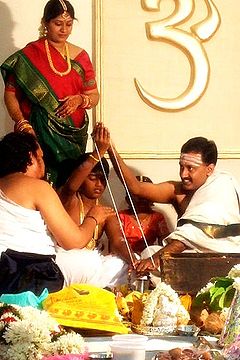
The sacred thread or Yajnopavita consists of three threads knotted
together. He who wears the thread should have a triple control, over his
mind, speech and body—thought, word and deed. The holy thread signifies
the various triads which exist in the world, viz., Sat, Chit and Ananda;
creation, preservation and destruction; the three states of waking,
dreaming and deep sleep; the three qualities of Sattva, Rajas and Tamas;
the Trimurtis Brahma, Vishnu and Siva; etc.
The staff signifies that the student should have control over his
thoughts, words and actions. He who practises control over his thoughts,
words and actions, and he who practises Brahmacharya in thought, word
and deed, attains perfection.
The boy wears a Kaupina, a small yellow cloth and a girdle of Munja
grass. The Acharya puts on him a deerskin. The new yellow cloth
represents the new body. Yellow colour is a symbol of spirituality.
Wearing of Kaupina indicates that the boy should lead a pure life of
perfect celibacy. The girdle is wound round thrice. This indicates that
the boy has to study the Samhitas, the Brahmanas and the Upanishads. The
deer-skin represents the ascetic life he should lead.
Samavartana
Then comes the end of the student stage, the Samavartana. The student,
having completed the Vedic studies and the Vratas, presents his
preceptor with a gift and obtains permission to take the formal bath
which marks the close of his student-career. He returns home and
performs the Samavartana, the returning ceremony. He is now ready to
marry and enter the second stage or Grihastha Asrama, the life of a
householder.
Vivaha
Vivaha is marriage or entry into the second Asrama. The life of the
householder begins. Now he takes up his duties as man and pays his
spiritual debts by sacrifice, by study and by procreating children. The
bridegroom tells the bride: “I take your hand for good fortune.” They
walk round the sacred fire hand-in-hand. The bride sacrifices grains in
the fire and prays: “May my husband live long. May my relations
increase.”
The Last Two Stages Of Life
There are two more stages, viz., Vanaprastha and Sannyasa, with their
rites.
Man withdraws himself from all worldly activities, retires into the
forest and prepares himself for taking Sannyasa. This is the life of a
Vanaprastha.
A Sannyasin renounces the world and leads a life of study and meditation
by living on alms.
Pretakarma is funeral rite. When a man dies, the funeral ceremonies are
performed by his son and heir.
The Pancha Mahayajnas
There are five great daily sacrifices that are to be performed by every
householder. They are: (i) Brahma Yajna, called also Veda Yajna,
sacrifice to Brahman or the Vedas or the sages; (ii) Deva Yajna,
sacrifice to the celestials; (iii) Pitri Yajna, sacrifice to the manes;
(iv) Bhuta Yajna, sacrifice to all the creatures; and (v) Manushya Yajna,
sacrifice to men.
The performance of these five Yajnas is conducive to the spiritual
evolution or growth of a man. He gradually learns that he is not a
separate entity or isolated creature or isolated unit, but is a part of
a great whole. He obtains knowledge by studying the sacred scriptures
written by great Rishis. He gets help from his friends, relatives and
fellow-beings. He parents gave his physical body. His body is nourished
by the milk of cows, grains, vegetables and fruits. The five elements
help him. He cannot live without oxygen and water. The Devas and the
Pitris bless him. Therefore, he owes a fivefold debt to Nature. He must
pay back his debt by performing these five sacrifices daily. Further,
numerous insects are killed by him unconsciously during walking,
sweeping, grinding, cooking, etc. This sin is removed by performance of
these sacrifices.
The Five Yajnas
The Rishis, the Devas, the Pitris, the Bhutas and the guests expect help
from the householders. Hence, they should perform these five sacrifices
daily. Teaching and study of scriptures is Brahma Yajna; Tarpana or
offering of water to the ancestors, and Sraaddha, form Pitri Yajna: Homa
or oblations into the fire is Deva Yajna; Bali or offering of food to
all creatures is Bhuta Yajna; and hospitality to guests is Manushya
Yajna or Atithi Yajna.
Brahma Yajna or Rishi Yajna
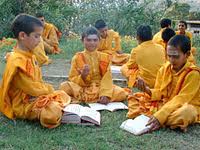 Every man should study daily the sacred scriptures. He should share the
knowledge with others. This is Brahma Yajna or Rishi Yajna. By so doing,
he pays the debt to Rishis.
Every man should study daily the sacred scriptures. He should share the
knowledge with others. This is Brahma Yajna or Rishi Yajna. By so doing,
he pays the debt to Rishis.
Deva Yajna
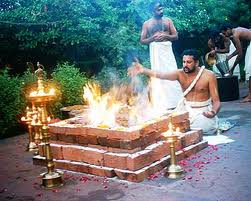 Lord Krishna says in the Bhagavad-Gita: “Having, in ancient times,
emanated mankind together with sacrifice, the Lord of Creation said, ‘By
this shall ye propagate; be this to you the fulfiller of desires. With
this, nourish ye the shining ones; and may the shining ones nourish ye.
Thus nourishing one another, ye shall reap the highest good. For,
nourished by sacrifice, the shining ones shall bestow on you the
enjoyments you desire. A thief verily is he who enjoyeth what is given
by them without returning them anything. The righteous, who eat the
remains of the sacrifice, are freed from all sins; but the unpious who
cook for their own sake, they verily eat sin,” (Ch. III-10, 11, 12, 13).
Manu says: “Let a man ever engage in the study of the Vedas and in the
rites of the Devas; engaging in the rites of the Vedas, he supports the
movable and the immovable kingdoms.” These sacrifices turn the wheel of
life in accordance with the divine will and thus help the evolution of
man and the worlds. Lord Krishna says in the Bhagavad-Gita: “Having, in ancient times,
emanated mankind together with sacrifice, the Lord of Creation said, ‘By
this shall ye propagate; be this to you the fulfiller of desires. With
this, nourish ye the shining ones; and may the shining ones nourish ye.
Thus nourishing one another, ye shall reap the highest good. For,
nourished by sacrifice, the shining ones shall bestow on you the
enjoyments you desire. A thief verily is he who enjoyeth what is given
by them without returning them anything. The righteous, who eat the
remains of the sacrifice, are freed from all sins; but the unpious who
cook for their own sake, they verily eat sin,” (Ch. III-10, 11, 12, 13).
Manu says: “Let a man ever engage in the study of the Vedas and in the
rites of the Devas; engaging in the rites of the Vedas, he supports the
movable and the immovable kingdoms.” These sacrifices turn the wheel of
life in accordance with the divine will and thus help the evolution of
man and the worlds.
Pitri Yajna
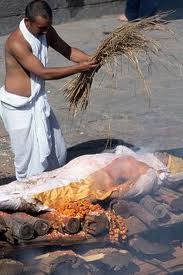 Offering libations, etc., to the forefathers, regularly, is Pitri Yajna. Offering libations, etc., to the forefathers, regularly, is Pitri Yajna.
Bhuta-Yajna
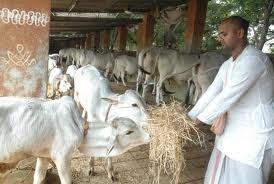 Distribution of food to cows, dogs, birds, fish, etc., is Bhuta Yajna. Distribution of food to cows, dogs, birds, fish, etc., is Bhuta Yajna.
Manushya Yajna
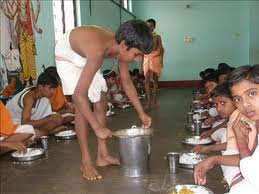 Feeding the poor is Manushya Yajna. Feeding the hungry, clothing the
naked, giving shelter to the homeless, comforting the distressed, etc.,
are all forms of Manushya Yajna. Any kind of service to the suffering
humanity is Manushya Yajna. Feeding a guest is Manushya Yajna. Feeding the poor is Manushya Yajna. Feeding the hungry, clothing the
naked, giving shelter to the homeless, comforting the distressed, etc.,
are all forms of Manushya Yajna. Any kind of service to the suffering
humanity is Manushya Yajna. Feeding a guest is Manushya Yajna.
Benefits Of The Pancha Mahayajnas
By daily doing such acts of kindness and sympathy, man develops mercy.
Hatred vanishes. His hard egoistic heart is gradually softened. He
cultivates cosmic love. His heart expands. He has a wider outlook on
life. He tries to feel his oneness with all beings. His old feeling of
separateness on account of selfishness and egoism is gradually thinned
and eventually eradicated. He learns that he can be happy only by making
others happy, by serving others, by helping others, by removing the
sufferings of others and by sharing what he has with others. The five
great daily sacrifices teach man his relations with his superiors, his
equals and his inferiors.
Man has no separate individual existence. He is connected with the
world. He is like a bead in the rosary. His whole life must be a life of
sacrifice and duties. Then only he will have rapid evolution. Then only
he will realise the supreme bliss of the Eternal. Then only he will free
himself from the round of births and deaths and attain immortality.
Sraaddha And Tarpana
Sraaddha is the name of the ceremonies performed by relatives to
help the Jiva who has cast off his physical body in death. A Jiva who
has cast off his physical sheath is called a Preta. The part of the
Sraaddha performed to help him at this stage is called the Preta Kriya.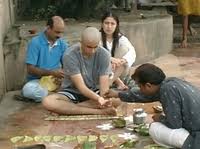
How Sraaddha And Tarpana Benefit The Departed Souls
Gifts to deserving Brahmanas for the benefit of the Pitris, in the
proper time and place and with faith, are known as Sraaddha. Sraaddha
gives satisfaction to the Pitris. By the offering of the sixteen
Sraaddhas, the son helps his father to dwell in joy with the Pitris. The
son should perform the Sapindikarana rites for his father. Performance
of Sraaddha and Tarpana relieves the hunger and thirst of the departed
soul during its journey to the Pitri Loka.
Those who go to hell are extremely oppressed by hunger and thirst.
Performance of Sraaddha and offerings of rice and oblations to them,
relieve their sufferings. Hence, performance of Sraaddha is
indispensable. Those who dwell in heaven also get satisfaction, strength
and nourishment.
The Advantages Of Cremation
Cremation is the best way of destroying a dead body. This is highly
beneficial for the departed soul. If the body is not burnt; the Jiva is
linked to the earth. The soul hovers round or hangs about the dead body
on account of Moha or attachment to the physical body. Its journey to
the celestial regions is interfered with. The vibrations set up by the
recitation of Mantras and the offerings and oblations of water, bring
solace and comfort to the departed soul. The Sapindikarana ceremony
helps the Jiva to pass from the Preta Loka to the Pitri Loka. He is then
enrolled among the Pitris or the ancestors. The son walks three times
round the dead body of his father before fire is set to the pyre and
sprinkles water once, reciting the Mantra: “Go away. Withdraw and depart
from here.” The bones are collected on the next day and thrown into a
river. Those who can afford take them to Benares or Haridwar and throw
them into the Ganga. It is believed that the soul whose mortal remains
are consigned to the sacred Ganga attains to the higher regions of
spiritual light and splendour and, in the end, salvation.
The Two Classes Of Pitris
Immediately after death, the Jiva obtains the Ativahika body which is
made up of fire, air and ether. Later on, it may have a Yatana Deha for
suffering the tortures of hell if it had done great sins on the
earth-plane, or a celestial body for enjoying the pleasures of heaven if
it had done virtuous actions while living in the world. In the Yatana
Deha, the air-element preponderates; while, in the celestial body, the
element of fire is dominant. It takes one year for the Jiva to reach the
Pitri Loka.
There are two classes of Pitris, viz., the celestial Pitris who are the
lords of the Pitri Loka, and the human Pitris who go there after death.
Brahma is the paternal grandfather of all. Kasyapa and the other
Prajapatis are also Pitris, as they are the original progenitors. Pitri
Loka or the Abode of the Pitris is also called by the name Bhuvar Loka.
The word Pitris primarily means the immediate ancestors, viz., father,
mother, etc. Sraaddha proper is performed for three generations of
Pitris, or to all Pitris. Three cakes are offered to the father, the
grandfather and the great grandfather. Two Brahmins are fed first. Seven
generations can mutually influence one another by the giving and
receiving of food.
Pitripaksha And Mahalaya Amavasya
The dark fortnight of the month of Asvayuja is known as the
Pitripaksha or the fortnight of the month specially sanctified for
offering oblations to the departed ancestors. And the last day, the day
of the new moon, is considered as the most important day in the year for
performing obsequies and like rites.
Now, ordinarily, the orthodox Hindus offer oblation of water—Tarpana-Arghya—to
the departed every new-moon day. The prescribed rites are also performed
every year on the anniversary of the day of death. This is the Sraaddha
ceremony. What, then, is the special import of these observances
particularly during the Asvayuja Krishna Paksha? The reason is that such
ceremonies done during this fortnight have a very special effect. The
offerings reach the Pitris immediately and directly, due to a boon from
Lord Yama. The occasion for the boon arose as follows:
Origin Of The Pitripaksha
A Story from the Mahabharata
The renowned hero of the Mahabharata, Danavira Karna, when he left the
mortal coil, ascended to the higher worlds and reached the region of the
heroes. There, the fruit of his extraordinary charity while upon earth
came to him multiplied thousandfold, but it came to him in the form of
immense piles of gold and silver. Karna had done limitless charity of
wealth, but had neglected to do Anna-Dana. Thus he found himself in the
midst of wealth and plenty, but with no food to appease him. He prayed
to Lord Yama. The Great Ruler responded to Karna’s prayer and granted
him a respite for fourteen days to return to the earth-plane once again
and make up for his former neglect. Karna came down from the Mrityu Loka,
and for fourteen days, he fed the Brahmins and the poor, and made
offerings of water, etc. He performed the prescribed rites also on the
last day. On his return once again to the higher world, the effect of
Karna’s observances during this fortnight removed all his wants there.
The time of this occurrence was the dark fortnight of Asvayuja.
Due to the grace of Lord Yama, it came to be so ordained that such rites
done at this particular period acquired the following unique merits.
Offerings made at this time reached all departed souls, whether they
were kins directly in the line of the offerer or not. Even those who
died without progeny received these oblations given on this Pitripaksha
Amavasya day. All those who had failed to do deeds of charity and
Anna-Dana and were thus denied these comforts in the Pitri Loka,
benefited by these ceremonies. Those deceased whose date of death is not
known and whose annual Sraaddha cannot be done, they also get these
oblations of Pitripaksha. Souls whose life was cut off by violent,
accidental or unnatural death and to whom, therefore, offerings cannot
reach in the ordinary course, to them, too, the Pitripaksha offerings
reach directly. All these the boon of Lord Yama made possible from the
time the great Karna performed the Asvayuja-Paksha rites. The Hindus now
observe this Paksha with great faith, with strict regulation, taking
bath thrice, with partial fasting, etc. On the newmoon day, Sarvapitri
Amavasya, the full rites are done and plenty of charity given.
Propitiation Of Departed Spirits
The day of Mahalaya Amavasya is a day of great significance and
importance to all Hindus. It is the annual festival for propitiating the
spirits of our ancestors, with devout prayers for peace. The Hindu
Itihasas say, that on the Mahalaya Amavasya, there is a conjunction of
the sun and the moon and that the sun enters the sign Virgo (Kanya). On
this day, the departed manes, i.e., our ancestors, leave their abode in
the world of Yama and come down to the world of mortals and occupy the
houses of their descendants.
The fortnight preceding the new moon is specially consecrated for the
propitiation of such departed spirits. The ceremonies performed in
honour of the manes or ancestors during each day of this fortnight are
considered to be equal to those performed at Gaya. The principle in all
such rites is the worship of the departed souls and the satisfaction of
their wishes so that they might be in peace during the rest of the year.
Navaratri Or The Nine-Day Worship Of Devi
Religious observances, traditional worship and Vratas have, at times,
more than one significance. Apart from being the adoration of the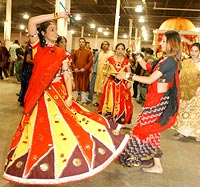 Divine, they are commemorative of stirring bygone events, allegoric when
interpreted from the occult standpoint, and are significant pointers
guiding the Jiva on his path to Realisation.
Divine, they are commemorative of stirring bygone events, allegoric when
interpreted from the occult standpoint, and are significant pointers
guiding the Jiva on his path to Realisation.
Outwardly, the nine days’ worship of Devi or the Mother, known as
Navaratri Puja, is in the nature of a Vijaya-Utsava. The nine days’
triumphs are offered to the Mother for Her successful struggle with the
formidable demons led by Sumbha and Nisumbha. But, to the spiritual
aspirant in his life of Sadhana, the particular division of the
Navaratri into sets of three days to adore different aspects of the
Supreme Goddess has got a very sublime, yet thoroughly practical, truth
to reveal. In its cosmic aspect, it epitomises the stages of the
evolution of man into God, from Jivahood to Sivahood. In its individual
import, it shows the course that his spiritual Sadhana should take.
Now, the central purpose of existence is to recognise your eternal
identity with the Supreme Spirit. It is to grow into the image of the
Divine. The Supreme One embodies the highest perfection. It is spotless
purity, Niranjana. To recognise your identity with That, to attain union
with That, is verily to grow into the very likeness of the Divine. The
Sadhaka has, therefore, as the initial step, to get rid of the countless
impurities and the undivine elements, that have come to cling to him in
his embodied state. Then he has to acquire lofty virtues and auspicious
divine qualities. Thus purified and rendered full of Sattva, Knowledge
flashes upon him like the brilliant rays of the sun upon the crystal
waters of a perfectly calm lake.
Worship Of Durga
The Eradication of Vices
This process of Sadhana implies resolute will, determined effort and
arduous struggle. In other words, strength, infinite Sakti, is the prime
necessity. It is the Divine Mother, Supreme Sakti of Brahman, that has
to operate through the aspirant. On the first three days, Mother is
adored as Power, Force—Durga, the Terrible. You pray to Mother Durga to
destroy all your impurities, your vices, your defects. She is to fight
with and annihilate the baser animal qualities in the Sadhaka, the lower
Asura in his nature. Also, she is the power that protects your Sadhana
from its many dangers and pitfalls. Thus, the first three days, marking
the first stage of destruction of Mala (impurities) and determined
effort and struggle to root out the evil Vasanas in your mind, are set
apart for the worship of the Destructive Aspect of the Mother.
Worship Of Lakshmi
The Cultivation Of Virtues
Once you have accomplished your task on overcoming the negative side,
that of breaking down the impure Vasanas, propensities and old habits,
the next step is to build up a sublime spiritual personality, to acquire
positive qualities in place of the eliminated Asuric qualities. The
divine qualities—Daivi Sampat—that Lord Krishna enumerates in the
Bhagavad-Gita have to be acquired. The Sadhaka must cultivate and
develop all the auspicious qualities. He has to pile up immense
spiritual wealth to enable him to pay the price for the rare gem of
divine wisdom (Jnana Ratna). If this development of the opposite
qualities (Pratipaksha Bhavana) is not undertaken in right earnest, the
old Asuric nature will raise its head again and again. Hence, this stage
is as important in an aspirant’s career as the previous one. The
essential difference is that while the former is a ruthless, determined
annihilation of the filthy, egoistic, lower self, the latter is an
orderly, steady, calm and serene effort to develop purity. This
pleasanter side of the aspirant’s Sadhana is depicted by the worship of
Mother Lakshmi. She bestows on Her devotees the inexhaustible wealth or
Daivi Sampat. Lakshmi is the Sampat-Dayini aspect of Brahman. She is
Purity Itself. Thus, worship of Goddess Lakshmi is performed during the
second set of three days.
Worship Of Sarasvati
The Dawn Of Supreme Wisdom
Once the aspirant succeeds in routing out the evil propensities and in
developing Sattvic, pure, divine qualities, he becomes an Adhikari. He
is ready now to receive the Light of Supreme Wisdom. He is fit to obtain
Divine Knowledge. At this stage comes the devout worship of Sri
Sarasvati, who is Divine Knowledge personified, the embodiment of Brahma
Jnana. The sound of Her celestial Vina awakens the notes of the sublime
Mahavakyas and the Pranava. She bestows the knowledge of the Supreme
Nada and then gives full Atma-Jnana as represented by Her pure dazzling
snow-white apparel. To propitiate Sri Sarasvati, the giver of Jnana, is
therefore, the third stage.
The tenth day—Vijaya Dasami—marks the triumphant ovation of the Jiva at
having attained Jivanmukti through the descent of Knowledge by the grace
of Goddess Sarasvati. The Jiva rests in its own supreme Self of
Sat-Chit-Ananda (Existence-Knowledge-Bliss Absolute). This day
celebrates the victory, the achievement of the Goal. The banner of
victory flies aloft. Lo! I am He! I am He! Chidananda Rupah Sivoham,
Sivoham; Chidananda Rupah Sivoham, Sivoham.
An Arrangement That Ensures Spiritual Success
This arrangement has also a special significance in the aspirant’s
spiritual evolution. It marks the stages of evolution which are
indispensable for every Sadhaka, through which every one should pass.
One naturally leads to the other, and to short-circuit this would
inevitably result in a miserable failure. Nowadays, many ignorant
Sadhakas aim straight at the appropriation of Knowledge without the
preliminaries of purification and acquisition of Daivi Sampat, and
complain that they are not progressing in the path. How can they?
Knowledge will not descend till the impurities are washed out and purity
is developed. The Sattvic plant can grow on no impure soil.
Follow this arrangement and your efforts will be attended with sure
success. This is your path. No other path is known for salvation.
Destroy all evil qualities and develop their opposite virtues. By this
process you would soon bring yourself up to that perfection which would
culminate in the identity with Brahman, which is your Goal. Then all
knowledge will be yours, you will be omniscient and omnipotent, and you
will feel your omnipresence. You will see yourself in all. You will be a
Jivanmukta. You shall achieve eternal victory over the wheel of birth
and death, over the demon of Samsara. No more of pain, no more of
misery, no more of birth, no more of death for you. Victory, victory be
yours!
Glory unto the Divine Mother! Let Her take you, step by step, to the top
of the spiritual ladder and unite you with the Lord!!
|








 Every man should study daily the sacred scriptures. He should share the
knowledge with others. This is Brahma Yajna or Rishi Yajna. By so doing,
he pays the debt to Rishis.
Every man should study daily the sacred scriptures. He should share the
knowledge with others. This is Brahma Yajna or Rishi Yajna. By so doing,
he pays the debt to Rishis. Lord Krishna says in the Bhagavad-Gita: “Having, in ancient times,
emanated mankind together with sacrifice, the Lord of Creation said, ‘By
this shall ye propagate; be this to you the fulfiller of desires. With
this, nourish ye the shining ones; and may the shining ones nourish ye.
Thus nourishing one another, ye shall reap the highest good. For,
nourished by sacrifice, the shining ones shall bestow on you the
enjoyments you desire. A thief verily is he who enjoyeth what is given
by them without returning them anything. The righteous, who eat the
remains of the sacrifice, are freed from all sins; but the unpious who
cook for their own sake, they verily eat sin,” (Ch. III-10, 11, 12, 13).
Manu says: “Let a man ever engage in the study of the Vedas and in the
rites of the Devas; engaging in the rites of the Vedas, he supports the
movable and the immovable kingdoms.” These sacrifices turn the wheel of
life in accordance with the divine will and thus help the evolution of
man and the worlds.
Lord Krishna says in the Bhagavad-Gita: “Having, in ancient times,
emanated mankind together with sacrifice, the Lord of Creation said, ‘By
this shall ye propagate; be this to you the fulfiller of desires. With
this, nourish ye the shining ones; and may the shining ones nourish ye.
Thus nourishing one another, ye shall reap the highest good. For,
nourished by sacrifice, the shining ones shall bestow on you the
enjoyments you desire. A thief verily is he who enjoyeth what is given
by them without returning them anything. The righteous, who eat the
remains of the sacrifice, are freed from all sins; but the unpious who
cook for their own sake, they verily eat sin,” (Ch. III-10, 11, 12, 13).
Manu says: “Let a man ever engage in the study of the Vedas and in the
rites of the Devas; engaging in the rites of the Vedas, he supports the
movable and the immovable kingdoms.” These sacrifices turn the wheel of
life in accordance with the divine will and thus help the evolution of
man and the worlds. Offering libations, etc., to the forefathers, regularly, is Pitri Yajna.
Offering libations, etc., to the forefathers, regularly, is Pitri Yajna. Distribution of food to cows, dogs, birds, fish, etc., is Bhuta Yajna.
Distribution of food to cows, dogs, birds, fish, etc., is Bhuta Yajna. Feeding the poor is Manushya Yajna. Feeding the hungry, clothing the
naked, giving shelter to the homeless, comforting the distressed, etc.,
are all forms of Manushya Yajna. Any kind of service to the suffering
humanity is Manushya Yajna. Feeding a guest is Manushya Yajna.
Feeding the poor is Manushya Yajna. Feeding the hungry, clothing the
naked, giving shelter to the homeless, comforting the distressed, etc.,
are all forms of Manushya Yajna. Any kind of service to the suffering
humanity is Manushya Yajna. Feeding a guest is Manushya Yajna.
 Divine, they are commemorative of stirring bygone events, allegoric when
interpreted from the occult standpoint, and are significant pointers
guiding the Jiva on his path to Realisation.
Divine, they are commemorative of stirring bygone events, allegoric when
interpreted from the occult standpoint, and are significant pointers
guiding the Jiva on his path to Realisation.